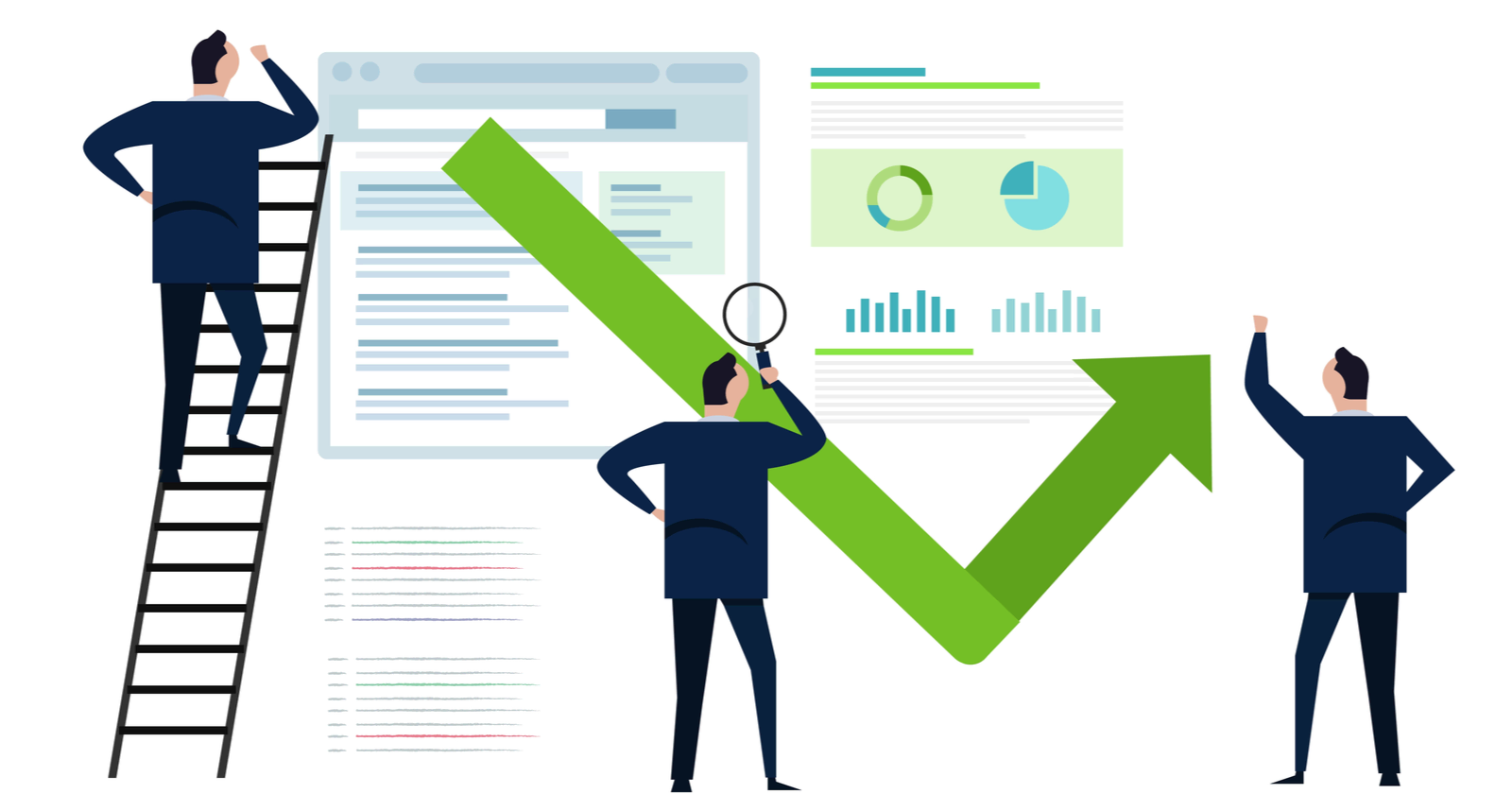What Is Bounce Rate — And What’s a Good Bounce Rate for Your Website?
Bounce rate can be considered as one of the most important and most misunderstood criteria in the Google ranking system. About what bounce rate a site should have is a question that many managers are looking for an answer to. In this article, we are trying to give a suitable answer to this question and provide solutions to improve the bounce rate.
The topics discussed in this article are:
- Definition of bounce rate
- How to check the bounce rate in Google Analytics?
- What should your bounce rate be?
- Why is your bounce rate so high?
- Is a high bounce rate always bad?
- E-commerce and bounce rates
- How to reduce bounce rate?
- What does bounce rate mean?
What is the Bounce Rate?
Google’s definition of bounce rate is as follows: “The percentage of time spent on a page during a visit”. This definition is a bit vague. If we want to define it more precisely, the bounce rate is the percentage of visits during which the user immediately exits the page without interacting with it.
In other words, “bounce” means visitors leave your website without clicking on other pages. Hence, the bounce rate is the percentage of people who do so.
How to check the Bounce Rate in Google Analytics?
You can see the bounce rate of your website by visiting the Audience > Overview section.
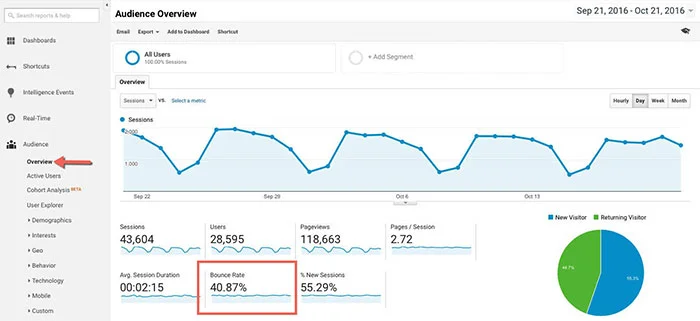
This is the overall bounce rate of your website. But your website actually has multiple bounce rates. The bounce rate of each page shows the performance of visitors who entered that page and “bounced” from there. In addition, the bounce rate of each device shows the percentage of people who used a mobile, tablet, or computer and jumped from the page. We will look at each of these bounce rates later, but for now, we want to talk about the overall bounce rate.
Key factors affecting the bounce rate of a website
The bounce rate of your website depends on several factors. These key factors include the following:
– The Type of traffic you attract
Are your website visitors specifically looking for your company, or are they just looking for information? People who are familiar with your website are less likely to bounce than people who are just looking for information. If you have an online store, are people going to buy from you or are they just researching for their next purchase?
– The Source of your website traffic
Visitors who are directed to your website through Google search results have a much lower bounce rate than visitors who come from, say, Facebook.

– The Pages your visitors land on
For example, unrelated blog pages have higher bounce rates than product or service pages. If people land directly on your home page, they probably shouldn’t jump right away. But if they land on an old blog page that has nothing to do with other pages on your website, there will be a high bounce rate.
– Design and layout of your website
Sites that are difficult to navigate, confusing, or look mundane have higher bounce rates than new sites that are easy to navigate and mobile-friendly. Is your site what people are looking for? If not, people will definitely leave your site.
– Clarity of the message you are conveying
People are busy, and if they can’t find what they want quickly, they won’t put more effort into finding it and will leave your site. This is one of the important reasons for the high bounce rate, which is often underestimated.
– Speed and usability of the website
Websites with slow load times have higher bounce rates and lower conversion rates.
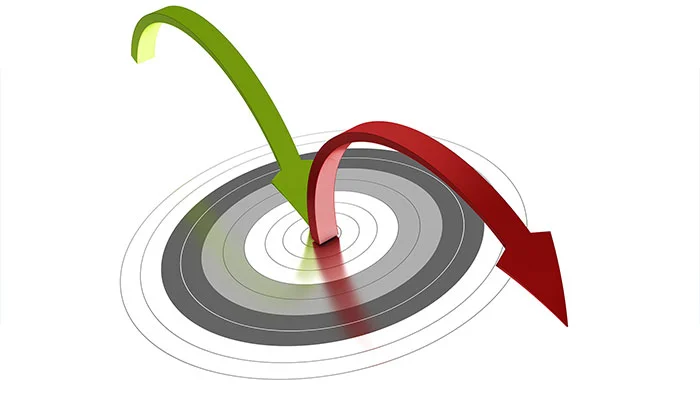
What should be the bounce rate of my website?
The general rule is that you should have a bounce rate below 40%. Usually, between 40% and 55% is also good, but a bounce rate higher than 55-65% means you need to optimize. If your bounce rate is above 90% or below 20%, there is probably a problem with your monitoring or coding.
This is a general and comprehensive rule, and there may be situations where even having a higher bounce rate than these seems completely reasonable.
Why is my website’s Bounce Rate so high?
The First reason for a high bounce rate is paid traffic or traffic driven by social networks.
If a high percentage of your traffic comes from social media or paid advertising, it may affect your website’s average bounce rate, as these visitors usually have a high bounce rate. In the example below, you can see that the bounce rates from paid search (row 4, 88%) and social networks (row 5, 70.98%) are much higher than regular search (44.79%), direct traffic (39.76%), and referral traffic (37.83%).

It is quite normal for the traffic bounce rate resulting from a paid search to be higher than a normal search, but in this example, the bounce rate is exactly twice the bounce rate of natural search. There are several possibilities for this issue. The first possibility is that these advertisements attract inappropriate traffic, for example, because the advertisement in question contains sentences that are not related to this business. The second possibility that can be considered for this issue is that the home page of this website is not working well in converting the traffic from advertisements into customers.
In the example below, you see a website with an average bounce rate of 75.33%. At first glance, this figure seems catastrophic. If you take a look at the details of the site’s traffic origin, you will notice that a large amount of this website’s traffic comes from social networks, and its average bounce rate is also high for that reason. In fact, if we factor in the bounce rate from social media inputs, the bounce rate from regular searches is 38%. This is just a little more than the desired amount (30-34%), which is not catastrophic at all.

The things that this website can do in this regard include the following:
Find out how to maintain this traffic from social networks for a longer period of time (it is possible that the site’s mobile responsiveness issues are the cause of this problem).
Try to attract more organic traffic because this type of traffic is currently low, but has the highest number of real visitors and conversions.
The second Reason for a high bounce rate is blog content that drives traffic.
As you know, writing interesting content for your blog can attract a lot of traffic. But this traffic is often for those types of people who are only looking for information and do not have high business goals. Hence, the traffic that is attracted to the blog content will have a higher bounce rate than the traffic that comes to your website’s homepage.
Below is an example of an accounting website that has a great blog section. This page shows the bounce rate associated with a website’s pages (white bars) compared to its blog content (red bars). You can see how blog pages have a higher bounce rate (93%) than website home pages. You might think that this means that the quality of blog content is not high enough, but if you look at the “average time spent on page” section, you will find that, on average, people spend almost six minutes reading content on blogs. They pass, which indicates the appropriate quality of its contents.

This website only needs an attractive call to action key in its blog content.
The question that arises here is what should be done to keep blog traffic on the website for a longer period of time.
One way to do this is to use relevant internal links to other blog content so that the reader can dive deeper into content that interests them. Another way to keep these visitors is to use a call to action (Call to Action) at the end of all blog content, which is also interesting for readers.
Keep in mind that blog visitors usually have little commercial intent (i.e., they are in the research phase and don’t intend to buy yet), so introducing the products and services you offer won’t always be the right thing to do. Instead, offering a short course that further defines blog content and requires their email and name can be a more appropriate decision. Do you have an email newsletter they can subscribe to? Do you have a free consultation to offer them?
The Third reason for high bounce rates is high mobile traffic
Mobile visitors have a higher bounce rate, so if your website has a lot of mobile visitors, you should expect a higher average bounce rate.

Note that this site receives approximately 65% of its traffic from mobile phones and tablets. You can also see how mobile traffic has a 53% bounce rate, which makes this website’s average bounce rate 44%. Of course, this mobile bounce rate is not that bad, especially since a high amount of traffic on this site is received from social networks. Therefore, although the site manager should try to keep mobile traffic longer, the truth is that it is currently performing very well. The 30% bounce rate for this website is very good and shows that the site is user-friendly.
With the increase in mobile users who use mobile devices for their searches, Google has been using this information to index websites for some time. This means that making your website responsive for mobile devices is more important than ever. By providing the best mobile experience for users, you can reduce the bounce rate of your website on mobile devices.
Reasons for unrealistically high or low bounce rates
If your website’s bounce rate is high for any of the reasons we mentioned above, then read on to find out how you can reduce it and get more traffic. In this part of the article, we are going to briefly examine the unhealthy reasons that unrealistically increase or decrease the bounce rate.
The First reason: referrals or spam bots
Robots will often visit your website. Some of these robots are good and harmless (for example, the Google robot enters your website, reads the content, and gives a score to your website), but others are annoying and bad (such as robots that seek to steal content and put it on spam sites). Sometimes these robots are detected and entered into the statistical account through Google Analytics, and greatly change your statistical numbers because the traffic of robots will sometimes have a bounce rate of 0% or 100%.
In the example below, you can see that the average bounce rate for a commercial website is 27%. Referral traffic figures of 64% seem a bit high. Referral traffic includes visitors who clicked on a link from another website to your website.
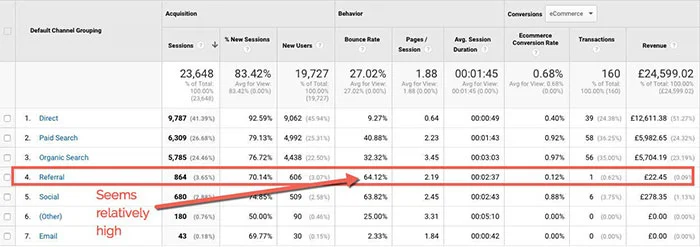
If we click on the referral traffic and take a closer look, we will notice that a lot of this referral traffic comes from two bots. As you can see, the bounce rate of this traffic is very high, and the reason is that its visitors are not real. This has caused the change and deviation of the average bounce rate of the referred traffic, and in the same way, the average bounce rate of the entire website has also deviated.

The Second Reason: incorrect settings
Wrong settings in Analytics can bring temporary happiness to website owners; surely, anyone will be very happy to see that their website’s bounce rate is 0%. But just when these people are at the height of their happiness, they will probably realize that their setup is not done well and there is a serious problem with their website.
Below is an example of a website that obviously had incorrect results. You can see how the bounce rate of this website is always either 100% or 0%.

Common reasons for displaying such strange results include having multiple instances of Analytics installed on the same page, conflicting codes, or placing the tracking code in the wrong place.
If you see strange numbers in Analytics, quickly download the Google Tag Assistant extension for Chrome and find the problem.
How to Optimize the Bounce rate of our website?
Now that we know what bounce rate we should have and the most common reasons for a high bounce rate, it’s not a bad idea to take a look at the ways that can be used to reduce the bounce rate and increase customer interaction with the website.
The easier it is for visitors to find your website, the less likely they are to skip your website. You should consider improving the user experience of the website as a never-ending process, and because of that, you should always be involved in testing, monitoring, and talking to customers. But just to have something that can be used quickly, it’s not a bad idea to review a few tricks to reduce bounce rates:
First Bounce Rate Reducer: Clear Navigation
Clear navigation makes it easy and fast for people to go where they want. See how Bathstore.com offers its shoppers several ways to shorten their shopping path in product selection. Their menus are as if a salesperson is asking customers what kind of bathroom equipment they need. No type? So, do you want to know what bathroom design you have? No? Do you want to see all the different designs we have for the bathroom? No? So, do you want to see the buyer’s guide for choosing the desired bathroom? With each option selected, these site navigation guides help confused customers make a hassle-free and easy purchase.
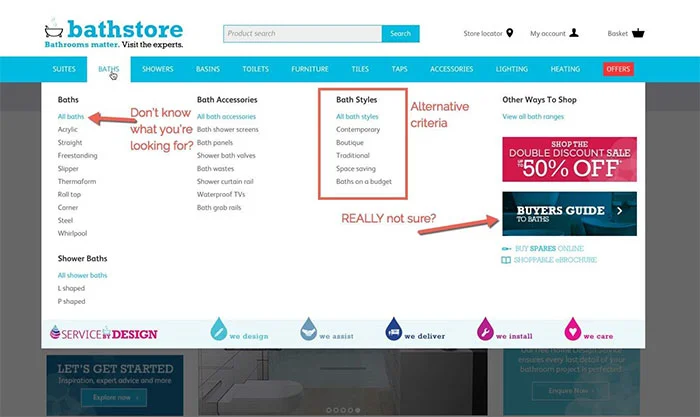
We see the complete opposite of this on Alfred Sung’s website. The screenshot below is taken from the website for buying glasses. This is the whole page of this website, and there is no section like a menu or at least several posts in it. To find the buyer’s menu, you need to scroll to the bottom left of the page. Of course, the menu itself also links to more irrelevant pages. This is a clear example of a website where “design comes first and marketing nothing,” and as a result, it will have a very, very high bounce rate.
Second Bounce Rate Reducer: Using the home page to stage and transition customers
Imagine the main page of the website as the lobby of a hotel. The duty of the lobby officer is as follows:
Finding reservations and making you feel comfortable. (This is where I want to be).
Tell you where to go and where your room is, where the cafe is, and where the restaurant is (this is where I need to go).
Your website’s home page acts like a lobby. It should tell people why they are here and where they should go. It should be as clear as a headline. Explain your work and tell who you are doing it for. How effectively your home page communicates this message has nothing to do with how it’s designed or how much it costs. E-commerce websites should use categories on the home page to direct customers to the category they need.
Third Bounce Rate Reducer: Placing Call-to-Action Buttons on All Pages
Keep in mind that not all visitors land on your website’s homepage, and sometimes they land on other side pages. See how every page on the Davis Associates website is designed to include the free consultation and call to action “Contact Us”. This will shorten the time and remove the hassle from the customer, and it will also improve your bounce rate.
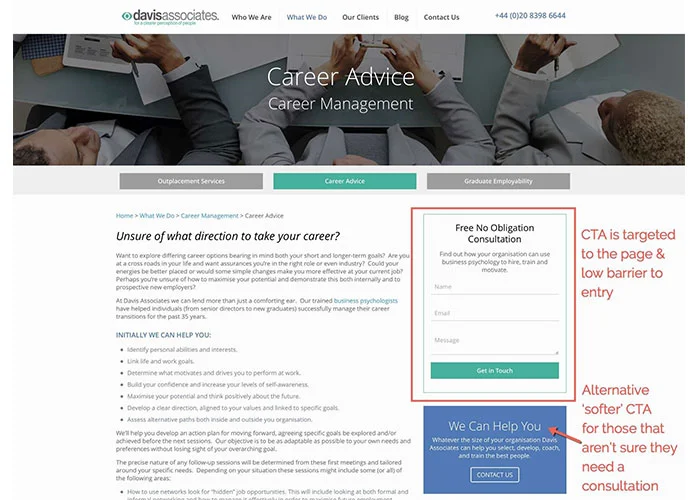
4th Bounce Rate Reducer: Speed up your website
According to Kissmetrics, 47% of people expect a web page to load within 2 seconds, and 40% of people will leave a page that takes more than 3 seconds to load. This research, conducted by SOASTA, found that just one second of extra page load time can increase bounce rates by 56%.
Therefore, it is better to reduce the size of images with Shortpixel, shorten and compress your Java and CSS scripts, and make sure that your servers are healthy and fast.
The Fifth bounce rate reducer: The right pop-ups and chats can reduce bounce rates.
There is a right way and a wrong way to use pop-ups on a website. In the picture below, we have given you an example of wrong use:

This pop-up is very simple and has no benefits, and calling the email list “promotional email list” is like calling it “spam email list”!
The right way to use pop-ups is to show them right when the person wants to leave the website. Just as they move the mouse to close the window, a well-timed pop-up can be a second chance, increasing time spent on the page and keeping them around for longer. Below is an example of a proper pop-up:
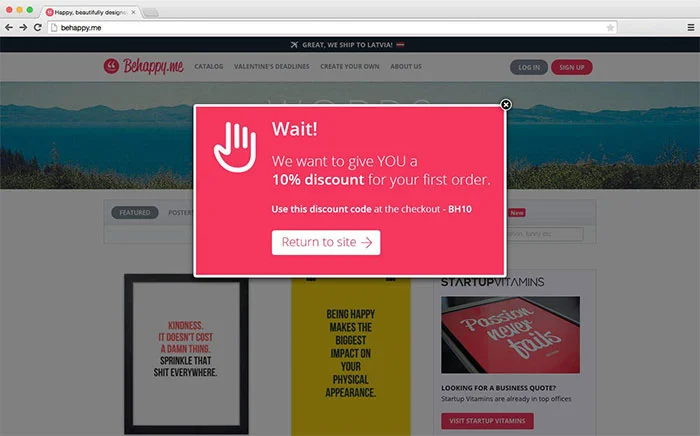
An exit pop-up that offers customers a discount to encourage them to stay on the website, just like a shopkeeper offers more discounts to potential customers who leave the store after haggling to stay and buy. Checkout pop-ups can also include more discounts, free gifts with purchase, free delivery, or anything free that can sweeten the deal.
If this type of pop-up does not agree with the goals and position of your store, or if your business is not an online business, you can offer something other than a discount in your pop-ups. You can put your social media membership key there and encourage people who leave your website to follow you on Facebook, or you can invite them to download an informative guide about your market, or you can link to a Provide useful content on your blog or invite them to a one-week online workshop and solve the problem they came to your website to solve in that workshop.
By following the above, you will be able to reduce the bounce rate of your website to an acceptable level. However, like any other topic in the digital marketing world, bounce rate is very broad, and many factors may increase bounce rate; there are many ways to reduce bounce rate. If you also have experience or a special opinion in this field, you can share it with us.
FAQ
What exactly is bounce rate?
Bounce rate is the percentage of visitors who land on a page and leave without interacting with other pages or elements.
Why does bounce rate matter?
A high bounce rate can reveal poor user engagement, irrelevant content, or website performance issues — but sometimes it’s normal for certain page types.
What is considered a “good” bounce rate?
Generally, 26–40% is excellent, 41–55% is average, and over 70% may be concerning — though it varies by industry and page type.
